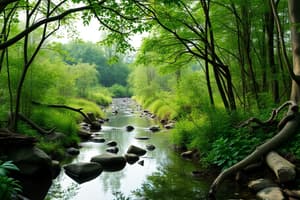Podcast
Questions and Answers
Which biome is characterized by high temperatures and low moisture levels?
Which biome is characterized by high temperatures and low moisture levels?
- Chaparral
- Temperate Deciduous Forest
- Boreal Forest
- Desert (correct)
What is a significant factor affecting the distribution of biomes?
What is a significant factor affecting the distribution of biomes?
- Soil type exclusively
- Population size and land development (correct)
- Plant species diversity
- Geographical features only
Which biome is best known for having frequent fires and nutrient-poor soil?
Which biome is best known for having frequent fires and nutrient-poor soil?
- Chaparral (correct)
- Boreal Forest
- Temperate Grassland
- Tundra
What climate characterizes the Temperate Grassland biome?
What climate characterizes the Temperate Grassland biome?
Which biome features low-growing vegetation and widespread permafrost?
Which biome features low-growing vegetation and widespread permafrost?
What is a primary consequence of hot, dry air in relation to vegetation?
What is a primary consequence of hot, dry air in relation to vegetation?
Which of the following best describes the characteristics of the tropical rainforest biome?
Which of the following best describes the characteristics of the tropical rainforest biome?
How does the rain shadow effect influence the surrounding areas?
How does the rain shadow effect influence the surrounding areas?
What defines biomes in terms of classification?
What defines biomes in terms of classification?
What typically differentiates coastal areas from inland regions in terms of climate?
What typically differentiates coastal areas from inland regions in terms of climate?
What primarily categorizes a biome?
What primarily categorizes a biome?
What is the main cause of unequal heating of the Earth's surface?
What is the main cause of unequal heating of the Earth's surface?
Which factor most directly influences atmospheric circulation?
Which factor most directly influences atmospheric circulation?
What characterizes a rain shadow?
What characterizes a rain shadow?
Which of the following is NOT a factor influencing climate?
Which of the following is NOT a factor influencing climate?
Which terrestrial biome is characterized by low rainfall and high temperatures, leading to unique drought-resistant vegetation?
Which terrestrial biome is characterized by low rainfall and high temperatures, leading to unique drought-resistant vegetation?
In which type of climate zone would you typically find abundant biodiversity?
In which type of climate zone would you typically find abundant biodiversity?
Which of the following factors is least likely to influence ocean currents?
Which of the following factors is least likely to influence ocean currents?
Flashcards
Desert biome
Desert biome
A biome characterized by high temperatures, low moisture, low plant abundance, but high diversity, with succulent or woody plants.
Chaparral biome
Chaparral biome
A biome with Mediterranean climates (cool, moist winters; warm, dry summers), featuring evergreen shrubs, frequent fires, and nutrient-poor soil.
Temperate Grassland
Temperate Grassland
A biome with warm, moist summers and cold, dry winters, dominated by grasses, and frequent fires & fertile soil.
Temperate Deciduous Forest
Temperate Deciduous Forest
Signup and view all the flashcards
Human Impact on Biomes
Human Impact on Biomes
Signup and view all the flashcards
Air Descending
Air Descending
Signup and view all the flashcards
Air Rising
Air Rising
Signup and view all the flashcards
Rain Shadow Effect
Rain Shadow Effect
Signup and view all the flashcards
Tropical Rainforest
Tropical Rainforest
Signup and view all the flashcards
Savanna
Savanna
Signup and view all the flashcards
Ecology
Ecology
Signup and view all the flashcards
Abiotic Factors
Abiotic Factors
Signup and view all the flashcards
Biotic Factors
Biotic Factors
Signup and view all the flashcards
Biome
Biome
Signup and view all the flashcards
Climate
Climate
Signup and view all the flashcards
Solar Radiation
Solar Radiation
Signup and view all the flashcards
Rain Shadow
Rain Shadow
Signup and view all the flashcards
Atmospheric Circulation
Atmospheric Circulation
Signup and view all the flashcards
Study Notes
Introduction to Ecology
- Ecology is the scientific study of interactions between organisms and their environments
- Abiotic factors are physical aspects of the environment (e.g., sunlight, temperature, water)
- Biotic factors are other organisms (e.g., plants, animals, bacteria)
Levels of Ecological Organization
- Organism: a single individual
- Population: a group of individuals of the same species in the same area
- Community: all the populations of different species in a given area
- Ecosystem: all the living organisms (biotic) and nonliving components (abiotic) in a particular area
Factors Influencing Climate
- Solar radiation: uneven heating of the Earth's surface drives atmospheric circulation
- Atmospheric circulation: global patterns of air movement impact moisture and temperature distribution
- Ocean currents: influence regional temperatures and climates
- Regional geography: mountains, valleys, and coastlines affect local climates
- Seasonal variation: changes in temperature and precipitation throughout the year determine species presence
Rain Shadow
- A dry region on the leeward side of a mountain range
- Warm, moist air rises on the windward side, cools, and releases precipitation
- As air descends on the leeward side, it warms and dries
Biomes
- Large-scale ecosystems categorized by dominant vegetation type
- Each biome has a characteristic climate, defining factors that determine species distribution
- Descriptions of each biome include temperature, precipitation, fire, and typical plant and animal species
Aquatic Ecosystems
- Photic zone: upper layer of water that receives enough sunlight for photosynthesis
- Freshwater ecosystems: lakes, ponds, streams, rivers
- Depth and area determine communities
- Marine ecosystems: oceans, estuaries, coral reefs, kelp forests, rocky intertidal, pelagic zone, and benthic zone
- Categorized by location relative to shorelines and ocean bottom
Human Impacts on Biomes
- Humans affect biome distribution through population size, land development, and resource use
- Deforestation: logging removes trees for wood and conversion of land to agriculture
- Desertification: conversion of grasslands to desert due to unsustainable grazing practices
Additional Information
- The biosphere is the zone of life on Earth.
- Terrestrial biomes include various ecosystems (e.g., deserts, grasslands, forests)
- Freshwater ecosystems include lakes and ponds
- Marine ecosystems include oceans, estuaries
Studying That Suits You
Use AI to generate personalized quizzes and flashcards to suit your learning preferences.




